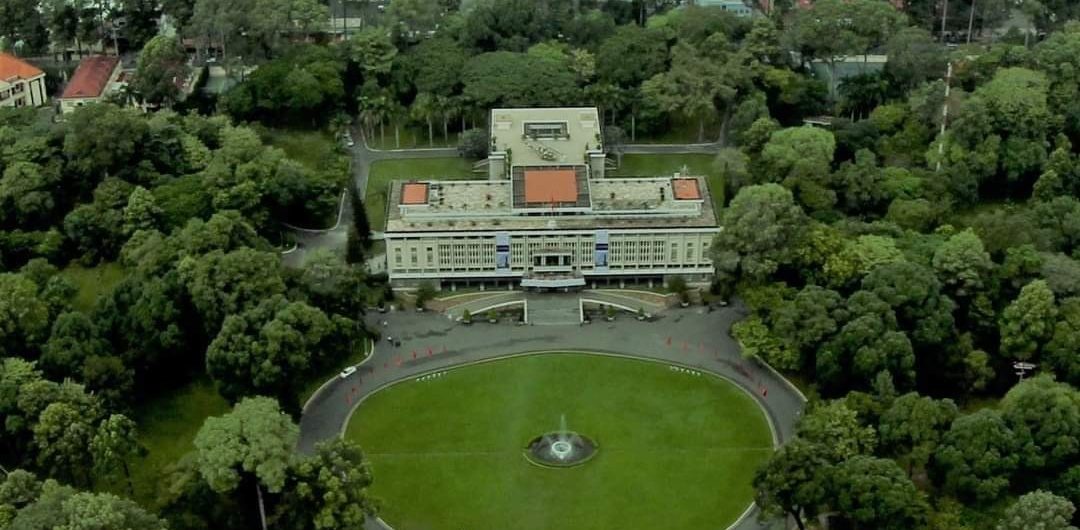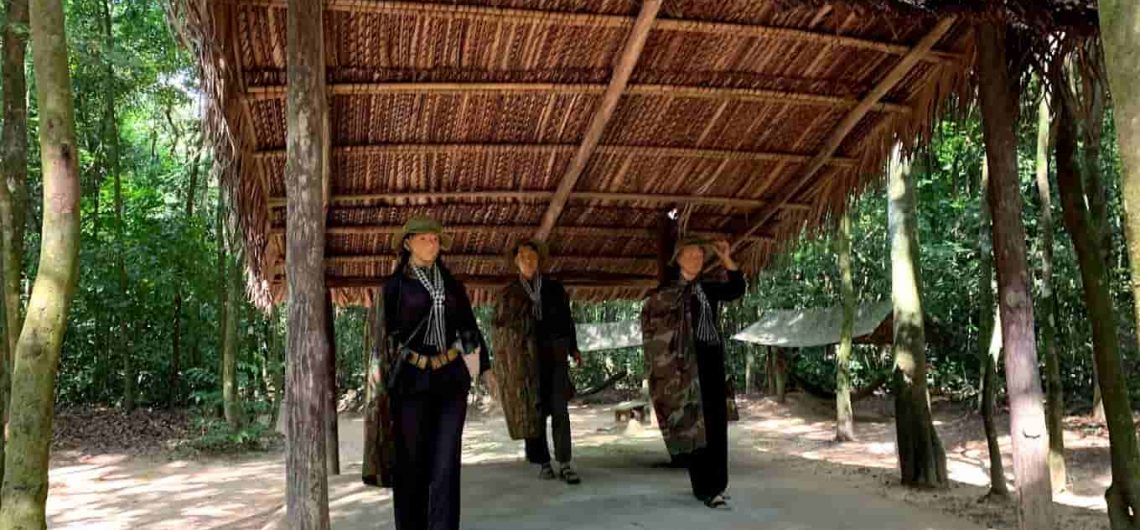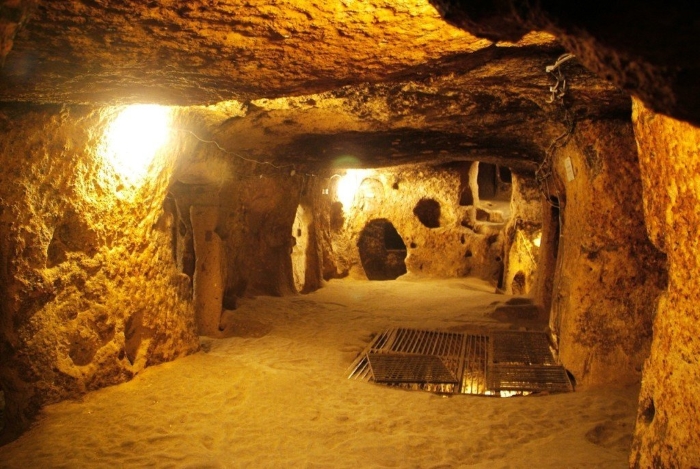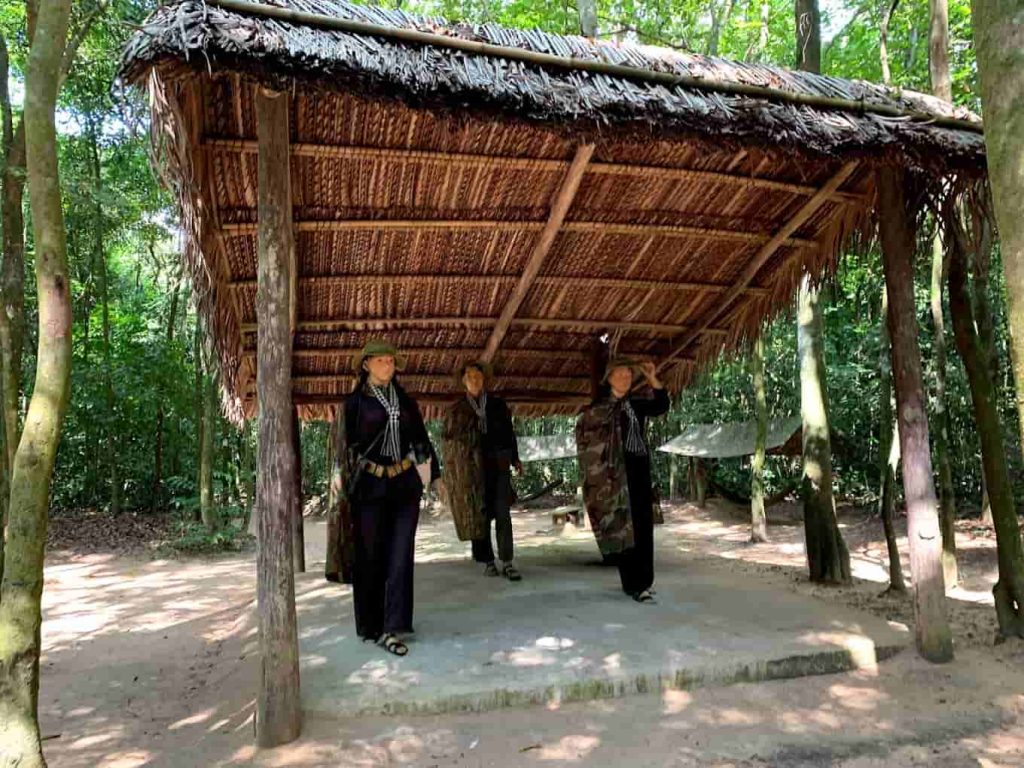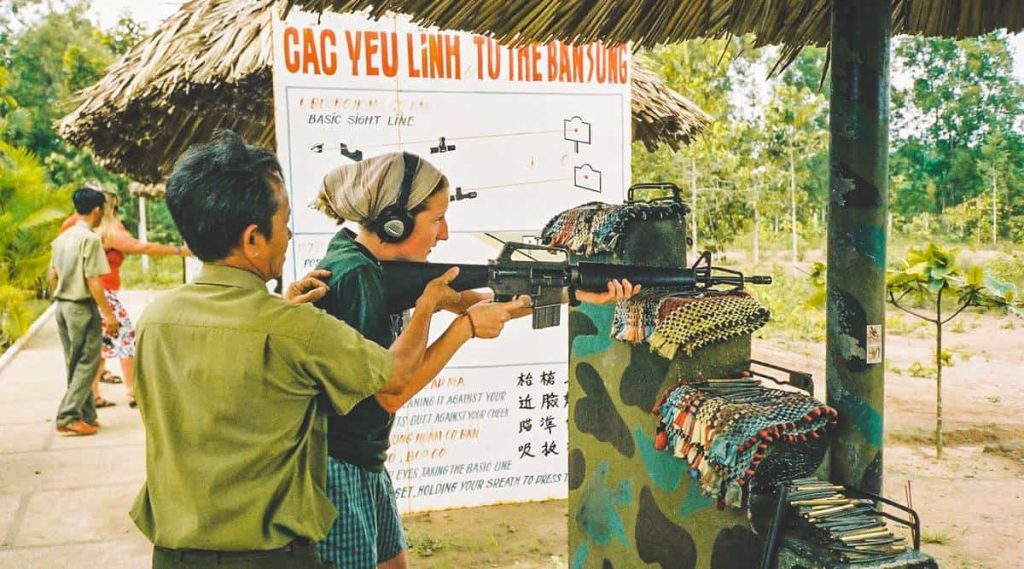Ho Chi Minh City, known as Saigon in the past, has always been famous for being the epicenter of all lifestyles, cultures, and extravagance of both the Eastern and Southwestern regions of Vietnam. Whether you’re a domestic or international traveler interested in learning about the history of this Vietnamese land, you should definitely visit Independence Palace at least once. As a living witness to tons of bombs and bullets during the years of war, with people coming and going, those in power rising and falling, Independence Palace has now become a part of life and memory, preserving a piece of the history of the people of Saigon.
Sometimes, a journey back in time can provide you with valuable experiences. Along with DanangPrivateCar.com’s travel insights, find out how much a ticket to explore and visit Independence Palace costs.
Historical Information about Independence Palace
In 1868, the French government began designing and constructing a mansion to serve as the residence for the Governor of Cochinchina in the center of Saigon, which was known as Dinh Norodom. The construction was initiated by the French Governor of South Vietnam, La Grandière, who laid the first stone on February 23, 1868, and completed the building in 1871. From that point until 1945, this mansion was used as the residence and workplace of the French Governors during the period of French colonization in Indochina.
On March 9, 1945, the Japanese invaders overthrew the French colonial rule and took control of Indochina, turning Dinh Norodom into the working place for the Japanese government in Vietnam. However, in September 1945, following their defeat in World War II, the French returned to occupy Southern Vietnam and continued to use Dinh Norodom as their headquarters.
On May 7, 1954, the French failed in the Battle of Dien Bien Phu, which forced them to sign the Geneva Accords and withdraw from Vietnam. Subsequently, the United States became involved in South Vietnam, leading to the division of our country into North and South.
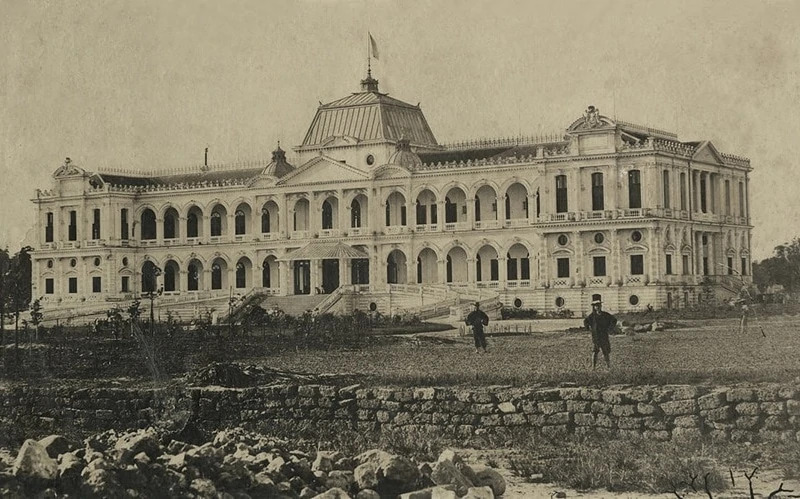
On September 7, 1954, Dinh Norodom was handed over from the French government, represented by General Paul Ely, to the government of Saigon, represented by Prime Minister Ngo Dinh Diem. At that time, Ngo Dinh Diem changed the name of the palace to Independence Palace. On October 26, 1955, Prime Minister Ngo Dinh Diem deposed Emperor Bao Dai, established the government of the Republic of Vietnam, and assumed the presidency. From that point, Independence Palace became the residence of the Ngo Dinh Diem family. Due to their autocratic regime and oppression of the people, Ngo Dinh Diem caused much discontent among the populace and internal government dissent in Saigon.
On February 27, 1962, Independence Palace was bombed, causing the entire left-wing of the palace to collapse. Ngo Dinh Diem had the site cleared and built a new mansion on the same grounds. The construction was unfinished when Ngo Dinh Diem was assassinated on November 2, 1963. Therefore, on the inauguration day of the palace on October 31, 1966, the presiding officer was President Nguyen Van Thieu.
On April 30, 1975, tanks from the Vietnamese People’s Army broke through the gates of the palace. When the flag of the National Liberation Front of South Vietnam was raised on the roof of the palace, it marked the liberation of South Vietnam, the reunification of North and South, ending over a hundred years of struggle against foreign invaders.
With its rich and tumultuous history, Independence Palace has become a very special national monument, attracting numerous domestic and international tourists and serving as an important venue for various meetings and events at the city and national levels. After over 100 years of history, Independence Palace still stands proudly, preserving its ancient beauty and harboring many secrets. It is an essential part of the Saigon identity.
Information about Independence Palace
Where is Independence Palace located?
Address of Independence Palace:
- 135 Nam Ky Khoi Nghia Street, Ben Nghe Ward, District 1, Ho Chi Minh City
- 106 Nguyen Du Street, Ben Nghe Ward, District 1, Ho Chi Minh City
Independence Palace in Saigon is also known by various other names such as Dinh Thong Nhat, Dinh Thong Doc, Dinh Norodom. The palace is situated in the central part of District 1, with its main facade on Nam Ky Khoi Nghia Street, the rear on Huyen Tran Cong Chua Street, the left side on Nguyen Thi Minh Khai Street, and the right side on Nguyen Du Street.

Ticket Prices for Independence Palace 2023
Does Independence Palace in Saigon sell admission tickets? Independence Palace in Saigon charges an admission fee, and the ticket prices for 2023 are as follows:
Independence Palace admission ticket:
- Adults: 40,000 VND per person
- Students: 20,000 VND per person
- Children: 10,000 VND per person
Independence Palace admission ticket + “From Dinh Norodom to Independence Palace 1868 – 1966” exhibition:
- Adults: 65,000 VND per person
- Students: 45,000 VND per person
- Children: 15,000 VND per person
What are the opening hours of Independence Palace?
The opening hours of Independence Palace are as follows:
- Visiting hours: Morning from 7:30 AM to 11:30 AM, and afternoon from 1:00 PM to 5:00 PM
- Ticket sales hours: Morning from 7:30 AM to 11:00 AM, and afternoon from 1:00 PM to 4:00 PM
How to get to Independence Palace
Getting to Independence Palace in Saigon is quite easy. If you have a personal vehicle, you can simply use Google Maps to search for the palace’s name, and it will provide detailed directions. For a more specific experience while visiting Independence Palace, you can park your car on Huyen Tran Cong Chua Street or in Tao Dan Park.

If you prefer to use public transportation, here are some bus routes that pass by Independence Palace:
- Route 001 (Ben Thanh – Cho Lon Bus Station)
- Route 002 (Ben Thanh – Western Bus Station)
- Route 03 (Ben Thanh – Thanh Loc)
- Route 04 (Ben Thanh – Cong Hoa – An Suong Bus Station)
- Route 05 (Cho Lon Bus Station – Bien Hoa)
Furthermore, after visiting Independence Palace and if you wish to explore more places, choosing a reliable means of transportation can save you time. You can consider using the Ho Chi Minh city private car services provided by Danang Private Car’s. Our drivers can pick you up from your hotel in Ho Chi Minh City or the airport and take you to your desired destinations, ensuring a hassle-free experience. Using private car services can be cost-effective and convenient for groups of friends, families, and international travelers, especially when navigating the public transportation system in Ho Chi Minh City might pose some challenges.
When is the best time to visit Independence Palace?
Most of the visitor areas are indoors, so they won’t be significantly affected by the weather. However, to avoid unfavorable weather conditions, it’s best to plan your visit during the dry season, with sunny and rain-free days, which typically runs from around April to December. Particularly, on important national holidays like April 30th, the palace also hosts many meaningful activities.
What Makes the Architecture of Independence Palace Special?
One of the aspects that leaves people in awe when learning about Independence Palace is its incredibly distinctive architecture.
Exterior Overview of Independence Palace in Saigon
Independence Palace is a unique architectural work designed by architect Ngô Viết Thụ. When designing this palace, he aimed to create a culturally significant structure, so all the interior and exterior elements are imbued with traditional Eastern cultural elements and a touch of modern architecture.
Notably, if you pay attention, the architecture of Independence Palace is intentionally modeled after beautiful Hán-Việt characters, as follows:
- The entire facade of the palace is shaped like the character “CÁT” (吉), meaning good fortune and luck.
- The top floor has the character “KHẨU” (口) in the shape of a gate, symbolizing the importance of education and freedom of speech.
- The “KHẨU” (口) character has a central flagpole with vertical lines, forming the character “TRUNG” (中), signifying the need for balance and justice for democracy.
- The roof’s four-sided awnings have horizontal lines creating the character “TAM” (三), representing the three elements of Humanity, Wisdom, and Bravery in individuals.
- These three horizontal lines are connected to the vertical lines, forming the character “VƯƠNG” (王) with a tower on top creating a dot, forming the character “CHỦ” (主), symbolizing the sovereignty of the nation.
- On the front of the palace, the combination of the entire second and third floors, along with the entrance canopy and two wooden columns under the canopy, forms the character “HƯNG” (興), expressing wishes for eternal prosperity for the nation.
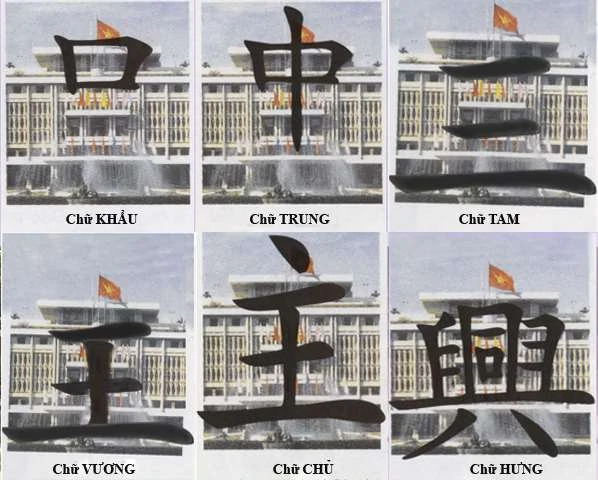
The architecture of Independence Palace is also exemplified by a stone flower pattern that simulates bamboo nodes, elegantly surrounding the second floor. This not only enhances the palace’s beauty but also serves to attract sunlight. Inside the palace, all lines and elements are characterized by straight lines, symbolizing the phrase “chính đại quang minh” (great virtue and bright truth) as the foundation.
Interior Inside Independence Palace, Saigon
Independence Palace features over 100 rooms, each decorated according to its specific purpose, often with different architectural styles. Architect Ngo Van Thu added an elegant and refined touch to Independence Palace through stone floral curtains that take the form of vertical bamboo stalks along the hallways on the second floor. These curtains serve multiple functions, including shading from the west, welcoming northern sunlight, wind protection, and subtle coverage.
Furthermore, the interior architecture of the palace maintains straight and flat lines, symbolizing “quang minh chính đại,” a concept of brightness and greatness.
Surrounding Landscape of Independence Palace, Saigon
In front and behind the palace, there are two green parks and artificial lakes, designed to regulate the air. In the early 1960s, this was one of the first architectural projects with an emphasis on green design.
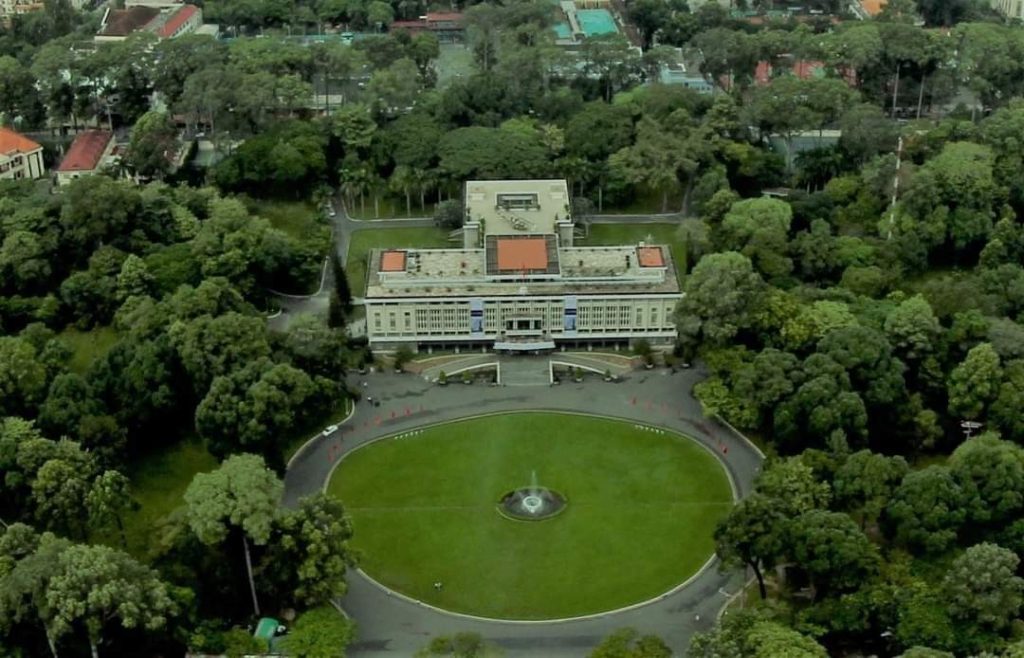
The front yard of Independence Palace is an oval-shaped grassy area with a diameter of up to 102 meters, providing a pleasant ambiance as you enter the gate. Additionally, there’s a lotus pond and semi-circular fountains running along the width of the grand hall, reminiscent of Vietnamese temples.
The palace grounds are mostly covered with lush green lawns, old trees providing ample shade, and precious ornamental plants. In the distance, on a raised plot of land in the left corner of the palace, there’s an octagonal pavilion with an open space used for relaxation.
What’s Inside Independence Palace?
Independence Palace is divided into three distinct areas: the permanent area, the thematic area, and the supplementary area. Each area has its unique characteristics, offering visitors different experiences to explore.
Permanent Area
Inside the permanent area of Independence Palace: This area is where the former government’s work and activities took place. Exploring various rooms, including the cabinet, the security council room, the ceremonial hall, the banquet hall, the president’s office, and the offices of officials, visitors will find documents, photographs, and artifacts that vividly and authentically recreate the historical events that transpired in these rooms.
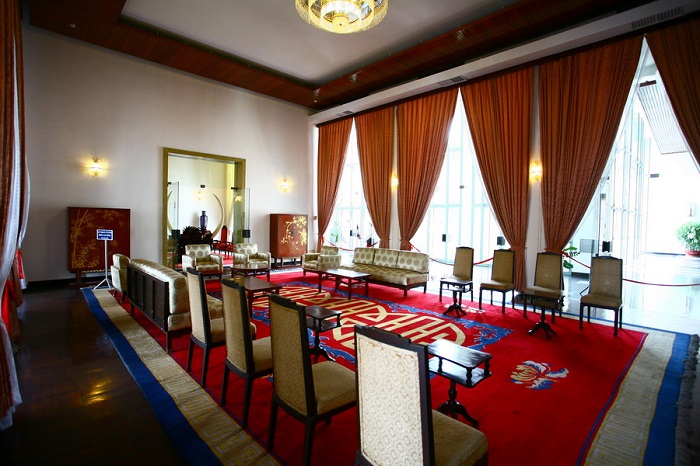
Thematic Area
Discovering the thematic area: Large exhibitions and thematic displays are held here. Many photographs taken and recorded in the past, accompanied by guided explanations, help visitors gain a better understanding of the challenges the city faced during various conflicts. In particular, the exhibition “From Dinh Norodom to Independence Palace 1868 – 1966” details the entire construction process and significant milestones of the palace.

Supplementary Area
The supplementary area: Over the years, a vast collection of rare documents and photographs, difficult to find elsewhere, have been gathered and displayed in this area.

Each photograph tells a story of the resilient and unwavering spirit of the Vietnamese people in their struggle. Looking at these images, visitors can feel a sense of pride and gratitude toward those who sacrificed and dedicated their lives to building a peaceful life for the people of Vietnam today.
Sights Near Independence Palace
The expected time to fully explore Independence Palace is approximately 2 hours. Therefore, you can combine your visit with some other nearby attractions such as:
- Ben Thanh Market (750m)
- Notre-Dame Cathedral of Saigon (400m)
- Bitexco Financial Tower (1.5km)
- Tao Dan Park (950m)
- 23/9 Park (1.6km)
- Nguyen Hue Walking Street (1.1km)
- Ho Chi Minh City Museum (350m)
- War Remnants Museum (650m)
Tips for Visiting Independence Palace – What to Keep in Mind
To have a meaningful and complete visit, here are some pocket tips and useful notes for travelers visiting Independence Palace.
- Where to buy Independence Palace admission tickets? You can easily park your vehicle and then move to the palace entrance to buy tickets directly at the ticket counter.
- On weekends, it’s advisable to arrive early to queue up for tickets, especially during peak hours because the palace only sells tickets from 8:00 AM to 3:30 PM.
- Dress neatly and respectably, and avoid clothing that is too revealing or too short when visiting historical sites.
- Pay attention to maintaining order while touring. Walk in an organized manner to facilitate listening to the guide and avoid disturbing other tour groups.
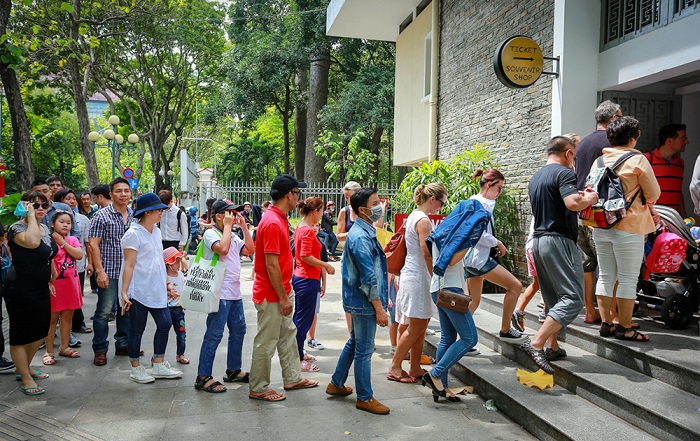
- A helpful tip: Don’t wear high heels if you plan to explore both the interior of the palace and the spacious outdoor area. Comfortable low-heeled shoes or sneakers will be much more suitable.
- Experience tells you not to touch or move any objects, paintings, or exhibits on display in the palace to avoid damage or altering their original positions.
- Travelers should be aware that some areas of Independence Palace may have signs prohibiting photography or smoking. Therefore, pay attention to the rules indicated on notice boards.
- During your visit, dispose of trash in the designated areas and maintain the cleanliness of the tour routes and spaces within Independence Palace.
- When touring the palace on hot, sunny days, it’s a good idea to bring some light snacks and drinks to replenish your energy if you start feeling tired.
Here are our guidelines for visiting Independence Palace in Saigon. We hope that DanangPrivateCar.com’s has provided you with useful information to fully explore Independence Palace. It can be said that Independence Palace is not only a famous tourist destination in Ho Chi Minh City but also a source of pride for the people of Vietnam in general. So, stepping inside to visit Independence Palace will undoubtedly be a memorable experience for any traveler.

